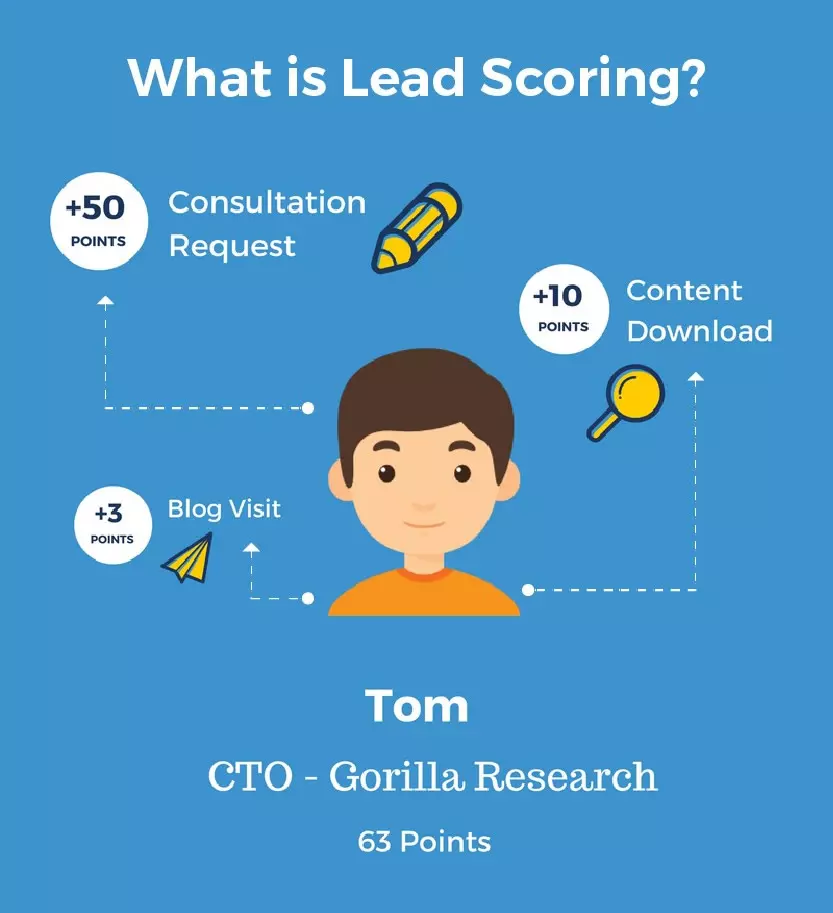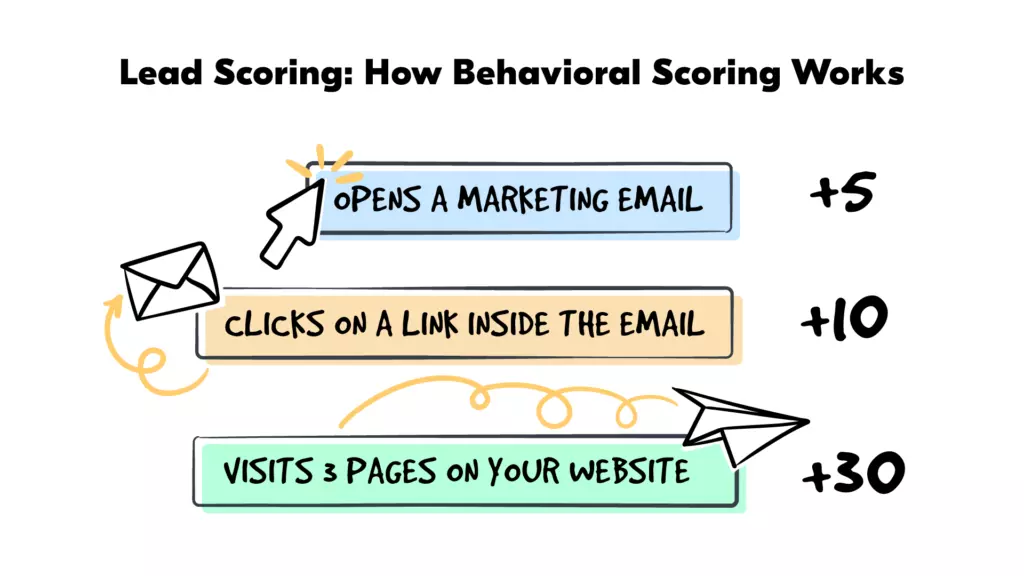All businesses need to generate leads if they want to be successful. When generating leads, you need to reach the people who are likely to become paying customers of your business.
With lead scoring, you will be able to get a clearer picture of the potential customers that are more likely to convert and which leads are unlikely to ever result in a conversion.
The whole process of lead scoring can help your business to get better leads and lead to more conversions.

Image Source: OnePageCRM
One specific method of lead scoring is email lead scoring. It is a powerful marketing tool that can help to increase click rates and conversions.
Email lead scoring is also a unique way to help you rank your email subscriber list, all based on the information you have about them and their customer behaviours.
How can you make sure that you do it the right way so that it benefits the business?
If you want to learn how you can use lead scoring to the advantage of your business, then read on.
Discover the world of email lead scoring so that your business can improve conversion, improve marketing strategy, and learn the best practices for using this effective tool for marketing.
What Is Email Lead Scoring?
Lead scoring is the process of giving values to each lead that you generate. This involves using a scale of numbers so that you can grade leads with different points.
The leads that have the more significant numerical value will be the most valuable leads for your business. They are more valuable because they are more likely to convert.
When you start to use lead scoring, you will score your leads due to several factors. You can give scores based on the information provided to you then they first submit to your email subscriber list.
You can score them on how they engage with your emails, brand, website, and brand.
It is vital to understand that the lead scoring you do will only be as effective as your complete understanding of the marketing plan or sales process. This is because lead scoring needs to understand what customers have done and who they are.
When you know and understand the steps people take when deciding to purchase from you, you can make those steps elements that can impact the lead score.
Lead scoring best practices
Knowing the leads you need to give a higher score to and prioritise will help you get a better hold of your potential customers.
Doing this helps to determine the likelihood that each lead is the ideal customer. One best practice for this is using a marketing automation system. By doing this, you can make sure that the leads that you score are more efficient.
One good way to assess the leads you have is by giving them data-driven scores from explicit and implicit information.
- Explicit data is solid and stays the same, such as being based on the size of your company or your headquarters location.
- Data that is implicit is more changeable and based on web page visits, information downloads, and email clicks.
All the data combined will help you have a clearer idea about each lead and its value to your business.
Lead scoring and SEO
If you want to look at the best practices for lead scoring, you need to consider SEO best practices. Using lead scoring software, you will be able to combine data found on-page and in-email.
Alongside behavioral analytics and data that you already had about the customer, this can be valuable information. This helps you to segment the lead, and then any content that you have can be optimised.
With this data, you can improve the behavioral signals of customers like engagement with a page. It can also help to improve your business’ organic website traffic.

Image Source: Outfunnel
Tips To Make Your Email Lead Scoring Better
By pairing lead scoring and email marketing together, you can more effectively find out how you can engage your email subscribers in a way that will lead to conversions.
How can you make sure that you make your email lead scoring better? Here are some elements to consider.
Make contact forms simpler
If you want to improve email lead scoring, then you need to have people getting your business’ emails.
You can do this in several ways, such as offering them exclusive content or a discount. If the contact form to sign up with isn’t clear or straightforward, then those potential customers could get lost and give up.
You don’t need a page full of information from them when they sign up, so keep it simple, and it is much more likely that people will sign up, and you’ll have more leads to score.
Use data-driven email frequency
As a general rule, the more emails you send out to your subscribers, the lower the click rate. You should think about how often you send the emails, and they need to be driven by data.
You need to test out what works well for your business and see what your customers respond to.
An eCommerce business that sends out time-sensitive deals to customers twice a week may see more engagement than other business industries emailing at the same rate.
You need to manage customer expectations too. If you state when they sign up, they will receive a daily email, they shouldn’t be surprised when they see a daily email.
Use CEO Messages
Creating loyal customers, who are the ones that are going to score well on lead scoring, involves getting them excited about your brand and your business.
Using a message from the CEO in an email newsletter can be an excellent way to make your email lead scoring better.
You will find out which customers are loyal and want to receive company updates and those who never open a CEO message email.
Use A/B testing
If you want to make your email lead scoring better, then you need to update the emails and the algorithm from time to time. Social media sites change up their algorithms regularly, so why not tweak what you do?
By using A/B testing, you can make sure that you are getting the most out of your emails and your lead scoring.
The length of the copy, the subject line, and other personalisations to the email can impact the email’s click-through rate.
Why High-Intent Customers Are Better
High-intent customers are a dream for any marketing team. They know what they are looking for, and they’re not just browsing your site randomly.
They want to find what they’re looking for and make an immediate purchase, and they are also one of the most likely groups of customers to convert. As a result, they need to be what you are aiming for.
High-intent shoppers can also be quite a fickle group. If they find your website through a search engine search, and it isn’t quite what they are looking for, they will quickly move on.
Equally, if your site doesn’t load well, high-intent shoppers can be put off by friction, so they are likely to move on if they can’t get what they want when they want it.
By optimising the whole experience for high-intent customers, it can mean a big difference between getting a quick conversion as well as a missed opportunity to sell.
SEO intent
As discussed, a high-intent shopper knows what they are looking for, and not only that, but they are easy to identify as most of them will arrive from a search.
When these shoppers search online, they are doing so with intent. If they don’t find what they are looking for, they will quickly click away to another webpage.
Your content needs to be ranking for search terms and keywords that these customers will be looking for.
When it comes to SEO, you should be thinking about the terms that will suit your customers.
These customers need to be highly interested in what you do and are ready to buy, rather than using generalised terms that are going to fit a larger number of customers, but not necessarily the customers that you are looking for.
Quite a few online shoppers, a whopping 93%, start their buying process using a search engine.
You will identify the customers who want to make a quick purchase and indicate a high-intent customer because of what they are searching for and by then assessing their search behaviour.
These customers could be looking for specific product names or transactional keywords, such as ‘free shipping’ or ‘product name and coupon‘.
For any SEO agencies looking at high-intent customers and why they are essential for business, there need to focus on revenue.
Revenue of a business is what comes from highly converting traffic, which includes high-intent customer traffic. The business revenue won’t come from website traffic alone; the two need to be combined to benefit the business.
Tools That Enable Your Email Lead Scoring Strategies
Email lead scoring helps you score leads based on the importance of each lead to the business, with factors indicating score by how many times they open your emails.
You can make all of this simpler for yourself by using built-in sales automation and marketing tools.
Here are some that you could consider.
HubSpot
This is an automation tool with a focus on inbound marketing. The tool targets intents such as getting more site visitors through SEO, ads, and social media, converting leads with analytics and CTAs, closing deals with CRM, and live chat, and then helping more customers with email marketing.
HubSpot also offers predictive lead scoring, eliminating the need for any manual scoring or setting the scoring up manually, so it can work well for any business starting with lead scoring for the first time.
The starter pricing is $38 a month, all the way up to $2,624 for their complete enterprise package.
Outfunnel
Outfunnel makes it easy to have data connections from your marketing tools and your CRM, as it can connect data from all of your marketing apps.
As it connects different tools, it can be a ‘deep dive’ on your data, which is more in-depth than some other tools out there for your lead scoring strategies.
Prices start from $19 a month, which is ideal for small businesses, to $125 a month for those looking for more marketing and sending over 50,000 emails per month.
Mailchimp
This email management software helps small businesses to do big things with tools and guidance along the way. You can automate marketing, create content, and then take action with the data insights that you can see when all connected.
Prices start from free for a basic email package to $299 a month for the premium package, including data and insights, comparative reporting, and advanced segmentation.
The world of SEO and digital marketing is changing all the time for small businesses. SEO just for your website isn’t enough; you should also focus on your customers and attract the customers that will be of most benefit to your business.
Using your email subscribers alongside SEO will help lead scoring so that you can find out the value in the customers you have and gain more.
High-intent customers and avoiding generic search terms are vital points, and automating with tools to help can be an essential part of the process.